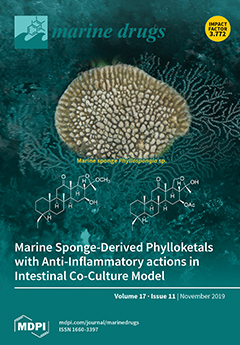Microcystins are cyclic heptapeptides from cyanobacteria that are potent inhibitors of protein phosphatases and are toxic to animals and humans. At present, more than 250 microcystin variants are known, with variants reported for all seven peptide moieties. While
d-glutamic acid (
d-Glu) is highly-conserved at position-6 of microcystins, there has been only one report of a cyanobacterium (
Anabaena) producing microcystins containing
l-Glu at the variable 2- and 4-positions. Liquid chromatography–mass spectrometry analyses of extracts from
Planktothrix prolifica NIVA-CYA 544 led to the tentative identification of two new Glu-containing microcystins, [
d-Asp
3]MC-ER (
12) and [
d-Asp
3]MC-EE (
13). Structure determination was aided by thiol derivatization of the Mdha
7-moiety and esterification of the carboxylic acid groups, while
15N-labeling of the culture and isotopic profile analysis assisted the determination of the number of nitrogen atoms present and the elemental composition of molecular and product-ions. The major microcystin analog in the extracts was [
d-Asp
3]MC-RR (
1). A microcystin with an unprecedented high-molecular-mass (2116 Da) was also detected and tentatively identified as a sulfide-linked conjugate of [
d-Asp
3]MC-RR (
15) by LC–HRMS/MS and sulfide oxidation, together with its sulfoxide (
16) produced via autoxidation. Low levels of [
d-Asp
3]MC-RW (
14), [
d-Asp
3]MC-LR (
4), [
d-Asp
3,Mser
7]MC-RR (
11), [
d-Asp
3]MC-RY (
17), [
d-Asp
3]MC-RF (
18), [
d-Asp
3]MC-RR–glutathione conjugate (
19), and [
d-Asp
3]MC-RCit (
20), the first reported microcystin containing citrulline, were also identified in the extract, and an oxidized derivative of [
d-Asp
3]MC-RR and the cysteine conjugate of
1 were partially characterized.
Full article






